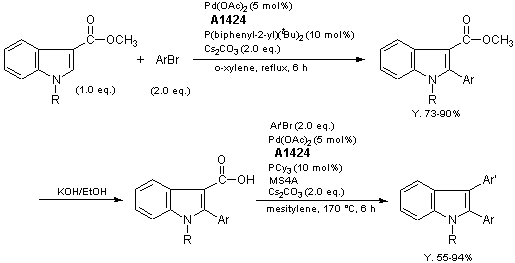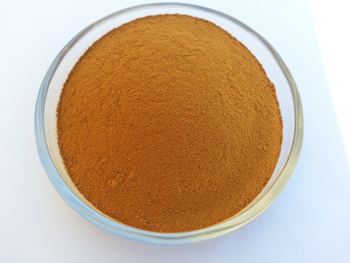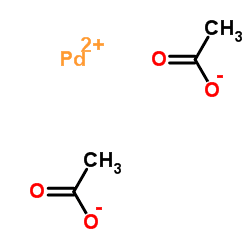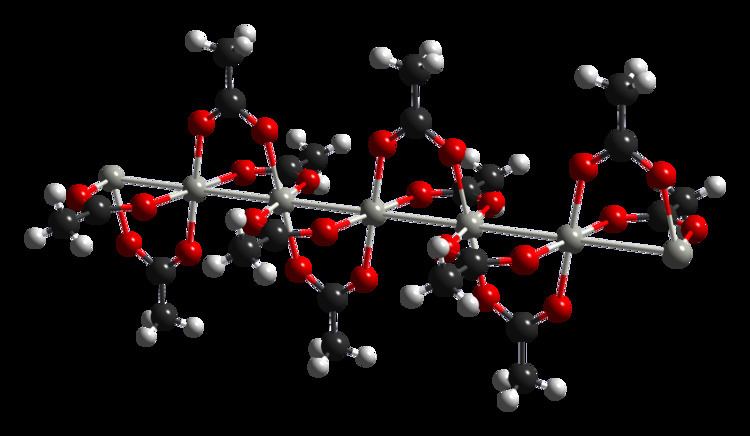Molar mass 224.5 g/mol Density 2.19 g/cm³ Appearance Brown yellow solid | Formula C4H6O4Pd Melting point 205 °C | |
 | ||
Palladium(II) acetate is a chemical compound of palladium described by the formula Pd(O2CCH3)2 or Pd(OAc)2. It is considered more reactive than the analogous platinum compound. It is soluble in many organic solvents, and commonly used as a catalyst for organic reactions and as a precursor for the synthesis of other palladium catalysts.
Contents

Structure

Although the compound is a 1:2 stoichiometric ratio of palladium atoms and acetate ligands as their oxidation states suggest, the actual molecular nature of the chemical depends on how it is prepared.

As prepared by Wilkinson and coworkers in 1965, and later studied by Skapski and Smart in 1970 by single crystal X-ray diffraction, palladium(II) acetate is a red-brown solid that crystallizes as monoclinic plates. Its structure was determined to be trimeric, consisting of an equilateral triangle of Pd atoms each pair of which is bridged with two acetate groups in a butterfly conformation. Each metal atom achieves approximate square planar co-ordination.

On the other hand, palladium(II) acetate prepared in a slightly different way was isolated as a pale pink powder, whose structure was determined by X-ray powder diffraction to consist of infinite chains of palladium atoms, each linked by an adjacent pair of acetate bridges to the next, in which the coordination geometry around each Pd is true square planar.
Preparation

Palladium acetate, in trimeric form, can be prepared by refluxing palladium sponge with hot glacial acetic acid and nitric acid. An excess of palladium sponge metal or nitrogen gas flow is used to prevent contamination by a material that contains a nitrite ligand in place of one of the acetates (Pd3(OAc)5NO2).
Pd + 4 HNO3 → Pd(NO3)2 + 2 NO2 + 2 H2OPd(NO3)2 + 2 CH3COOH → Pd(O2CCH3)2 + 2 HNO3The nitro variant has different solubility and catalytic activity in some reactions. Preventing, or controlling for the amount of, this impurity can be an important aspect for reliable use of palladium(II) acetate.
Palladium(II) propionate is prepared analogously; other carboxylates are prepared by reacting palladium(II) acetate with the appropriate carboxylic acid. Likewise, palladium(II) acetate can be prepared by reacting other palladium(II) carboxylates with acetic acid. This ligand exchange starting with a purified other carboxylate is an alternative way to synthesize palladium(II) acetate free from the nitro contaminant.
Reactions
When warmed with alcohols, or on prolonged boiling with other solvents, palladium(II) acetate decomposes to palladium.
Catalysis
Palladium acetate is a catalyst for many organic reactions by combining with many common classes of organic compounds such as alkenes, dienes, and alkyl, aryl, and vinyl halides to form reactive adducts. Alkenes and π-allyl coordination to palladium(II) acetate involves sigma-type donation from the pi orbital of the alkene or π-allyl with concomitant pi-backbonding into an empty pi* orbital on the alkene or π-allyl. The greater the sigma donation to the metal is, the greater the pi-backbonding. The greater the pi-backbonding is, the greater the reduction in the bond order of the alkene or π-allyl. Reduction of the alkenes or π-allyl by coordination to palladium(II) acetate reverses the reactivity of the organic ligand allowing them to undergo reactions with nucleophiles rather than electrophiles.
Examples of palladium(II) acetate catalyzed reactions are:
Pd(O2CCH3)2 converts aryl bromides into aryltrimethylsilanes, an important functional group in many organic compounds including the fungicide "Latitude".
RC6H4Br + Si2(CH3)6 → RC6H4Si(CH3)3 + Si(CH3)3BrPd(O2CCH3)2 is compatible with the electronic properties of aryl bromides, and unlike other methods of synthesis, this method does not require high pressure equipment.
Precursor to other Pd compounds
Palladium acetate is used to produce other palladium(II) compounds. For example, phenylpalladium acetate, used to isomerize allylic alcohols to aldehydes, is prepared by the following reaction:
Hg(C6H5)(CH3COO) + Pd(CH3COO)2 → Pd(C6H5)(O2CCH3) + Hg(O2CCH3)2Palladium(II) acetate reacts with acetylacetone (the "acac" ligand) to produce Pd(acac)2, a monomeric molecule that is a precursor to Pd(0).
Light or heat reduce palladium acetate to give thin layers of palladium and can produce nanowires and colloids.
